Building strong quads doesn’t require expensive gym equipment or complicated machines.
In fact, a simple resistance band can deliver impressive quad gains.
Today, I’m going to show you how to build stronger quads with only resistance bands. I’ll also include exercises that helped my clients increase their quad strength by 23% in just 8 weeks.
Here’s what you’re going to learn:
- Why resistance bands are scientifically proven to build muscle (backed by real studies)
- 7 quad-targeting exercises the pros use (with step-by-step form guides)
- My battle-tested quad workout program (that you can start today)
- Expert tips to maximize your results
But first, let me address the big question:
Do resistance bands actually work for building quad strength?
According to a 2019 study in the Journal of Sports Science & Medicine, resistance band training produced similar muscle gains to traditional weights when proper form and progressive overload were applied.
Let’s get started on building stronger, toned quads!
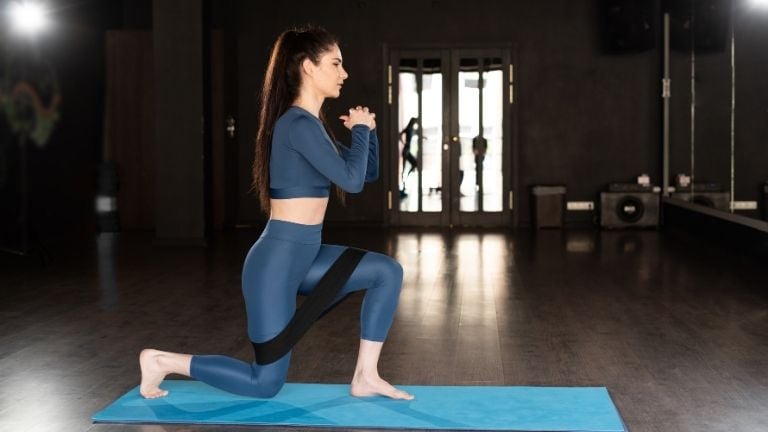
- Quadriceps Anatomy
- What Is Resistance Band Quad Workout
- The Magic Behind Band Training
- 7 Best Quad Exercises With Resistance Band
- 1. Resistance Band Squat
- 2. Resistance Band Leg Extension
- 3. Resistance Band Split Squat
- 4. Resistance Band Leg Press
- How To Do
- 5. Lateral Band Walks
- 6. Resistance Band Deadlift
- 7. Resistance Band Step-Ups
- Resistance Band Beginner Quad Workout Plan
- Intermediate Resistance Band Quad Routine
- Workout Plan:
- Conclusion
- Know More Resistance Band Exercises
- References
Quadriceps Anatomy
The quads, or quadriceps femoris, located in front of the thigh. They are the largest and strongest muscles in the thigh and play an important role in extending the knee and flexing the hip.
The four muscles of the quadriceps are:
- Rectus femoris: the longest muscle in the quadriceps, and it runs along the front of the thigh.
- Vastus lateralis: This muscle is located on the outside of the thigh. It is responsible for giving the thigh its shape.
- Vastus medialis: This muscle is located on the inside of the thigh and helps stabilize the knee joint.
- Vastus intermedius: This muscle is located in the middle of the thigh and helps extend the knee.
The four heads merge together, attach onto the patella (knee cap), and then insert via a single (patellar) tendon onto the tibia, just below the knee joint.
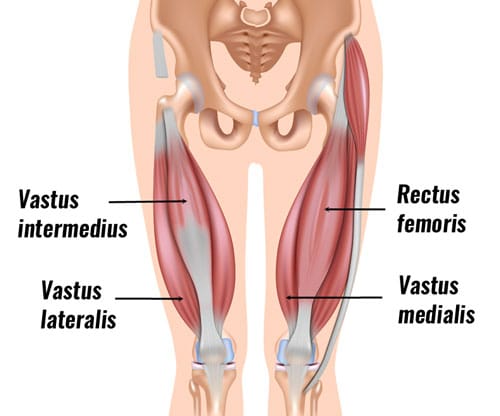
What Is Resistance Band Quad Workout
You’ve seen those colorful resistance bands at the gym and wondered if they actually work. Or maybe you’re skeptical about building serious quad strength without heavy weights.
I get it. I was too.
But here’s something interesting:
Research shows that resistance bands create something called “linear variable resistance,” which is a fancy way of saying they get harder to pull as you stretch them. This unique property makes them incredibly effective for muscle growth.
The Magic Behind Band Training
Here’s what makes resistance bands special:
- Concentric Phase (shortening): Think pushing up in a squat
- Eccentric Phase (lengthening): Think controlling the descent
With bands, you’re fighting resistance in BOTH directions. Traditional weights only challenge you on the way up.
The further you stretch the band, the harder it gets. This creates a natural intensity curve that matches your muscle’s strength curve.
The beauty of band training is that it hits all four heads effectively because:
- It maintains tension through full range of motion
- Allows natural movement patterns
- Adapts to your strength level
Quick Fact: A 2022 study found that band training produced comparable quad strength gains to traditional weight training when matched for intensity.
Want to know the best part?
You can do all this without risking joint stress, which often comes with heavy squats and leg extensions
Want to take your gains to the next level? Discover your daily calorie needs with our free TDEE calculator
7 Best Quad Exercises With Resistance Band
Here are the best 7 exercises for working out your quads with a resistance band. You can do them at home or while traveling. With just an elastic band, you can build a strong, toned leg.
1. Resistance Band Squat
The Resistance Band Squat is a powerhouse exercise that hits all the right muscles—quadriceps, hamstrings, glutes, and core. Forget the free weights and bulky gym machines; this move leverages a resistance band to ramp up the challenge for your legs.
You’re not just doing squats, you’re charging them up with resistance bands. The added load increases muscle activation, helping you build strength and power like never before.
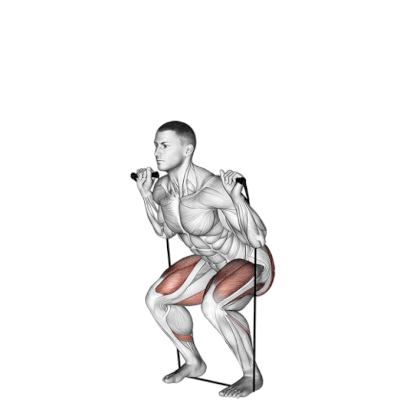
How To Do
- Start with your feet shoulder-width apart, knees bent, and toes pointed forward.
- Your toes point slightly outward, like you’re standing on the numbers 10 and 2 on a clock face. The resistance band lies flat beneath your feet, centered under your arches like a bridge supporting your stance.
- Grasp the band ends firmly at shoulder height, as if you’re about to start a boxing match. Your elbows naturally float near your ribcage, not flaring out.
- Begin by pushing your hips back, as if you’re reaching for a chair that’s just out of reach. Your knees start to bend, tracking over your toes like train cars following their rails.
- The band tension increases gradually as you lower, like a gentle spring coiling. Your thighs continue their journey until they’re parallel to the floor .
- At the bottom, you’ve created a perfect sitting position, though there’s no chair to catch you. It’s a momentary pause, like the quiet before a storm.
- Push through your entire foot, as if you’re trying to press your footprints into concrete. Your body rises as one unit, like a hydraulic lift – smooth, controlled, powerful.
2. Resistance Band Leg Extension
Unlike squats or leg press, band extensions eliminate “helper muscles.” Every ounce of tension hits your quads directly.
It is a great way to strengthen and tone your quadriceps muscles. This unilateral approach prevents muscle imbalances. To execute this exercise, you’ll only need a chair and a resistance band.
Traditional leg extensions can stress knee joints. But bands?
They create what scientists call “accommodating resistance” – meaning less stress, more gains.
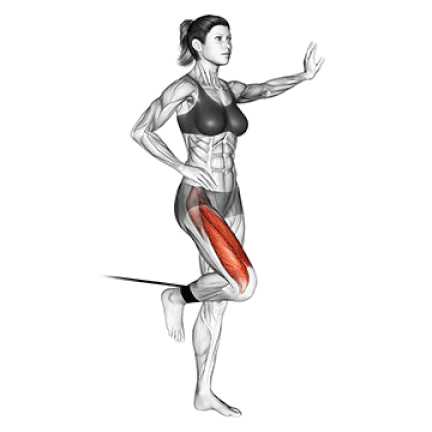
How To Do
- Position yourself on a stable surface, maintaining optimal spinal alignment.
- Create anchor tension by securing the band’s foundation point—either beneath your foot (engaging plantar mechanoreceptors) or chair leg.
- Loop the opposing end around your working ankle, establishing the resistance vector.
- Begin in the biomechanically advantageous 90-degree knee flexion position, where your quadriceps are in their mid-range loading state.
- Initiate the concentric phase through coordinated motor unit recruitment.
- Extend until you achieve near-terminal knee extension, maximizing quadriceps recruitment while maintaining protective co-contraction of surrounding musculature.
- Avoid hyperextension to protect joint mechanoreceptors. Implement a 2-second hold.
- Control the eccentric phase through gradual motor unit de-recruitment.
- Complete reps, then switch legs. Perform 2–3 sets per leg. Ensure you work both legs equally to avoid muscle imbalances.
3. Resistance Band Split Squat
Most people don’t realize this, but traditional split squats with dumbbells or barbells have a major flaw: the load gets easier at the top of the movement. Just when your muscles should be working hardest, they’re getting a break.
With bands, you’re fighting against increasing tension as you rise up. Your muscles face their greatest challenge precisely when they’re at their strongest point – at the top of the movement. This creates a unique growth stimulus that’s impossible to replicate with free weights.
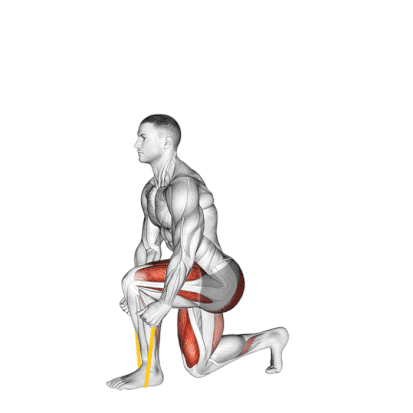
How To Do
- Stand tall, place a resistance band under your front foot, and maintain a posture that allows you to move freely.
- Your front foot is planted firmly – about 2-3 feet in front of your back foot.
- Keep your torso upright and confident. Your chest is up like you’re trying to show off a logo on your shirt.
- As you lower down, everything moves in harmony. Your front knee tracks over your toes like it’s on rails, and your back knee drops toward the ground.
- At the bottom position, your front thigh is parallel to the ground.
- Now drive back up with front heel. Push through it like you’re trying to leave a footprint in concrete. The band tension increases as you rise, challenging you most at the top when traditional squats would be easiest.
- The whole movement should feel smooth, controlled, and strong – like you’re moving through slightly thick honey.
4. Resistance Band Leg Press
While everyone thinks it’s just for quads, here’s what’s really happening: You’re hitting your entire lower body chain in one smooth movement. Your quads lead the charge, but your hamstrings, glutes, and calves are all putting in serious work. It’s like getting a full leg day in one exercise.
Now for the flexibility factor:
- Want to blast one leg at a time? Go unilateral.
- Need to handle more resistance? Hit both legs together.
- Looking to mix things up? Alternate between styles.

How To Do
- Lie down on the floor or a soft yoga mat. You want a stable surface that won’t slip.
- Make sure you’ve got enough space to fully extend your legs without hitting anything.
- Band placement is critical because the resistance band around your feet is like you’re lacing up expensive sneakers. The band should be snug but secure, not cutting off circulation.
- Bend those knees and nail that 90-degree angle with your thighs. Think tabletop position. Your back should be glued to the floor.
- Grip those band ends like you mean it. Pull them to your chest, keeping your elbows tucked (not chicken-wing style). Your shoulders should be relaxed, not creeping up to your ears.
- Push legs out like you’re pressing against a wall. Keep it controlled—this isn’t a kickboxing class. You want that band tension building gradually.
- Slowly (I mean SLOWLY) bring those legs back to start. Control is everything here.
- Rep It Out Shoot for 10-15 solid reps. Quality trumps quantity every single time.
5. Lateral Band Walks
You probably know dozens of leg exercises. But here’s the truth: Most of them completely miss those crucial outer hip muscles that keep you stable and strong.
Enter the Lateral Band Walk – the exercise that’s about to become your new best friend.
Why This Exercise Is a Game-Changer:
- Lights up your glute medius (that forgotten muscle most people ignore)
- Bulletproofs your hips for better performance
- Crushes those outer thigh muscles other exercises miss
- BONUS: Can save your back from pain (seriously)
Here are their variations
- Banded monster walks: To do banded monster walks, simply loop the resistance band around your ankles instead of your thighs.
- Banded side shuffles: To do banded side shuffles, simply shuffle sideways instead of walking.
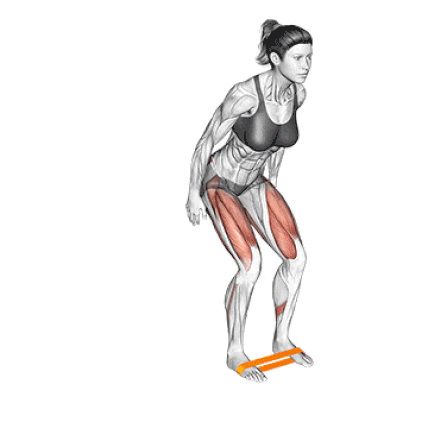
How To Do
- Take your resistance band and position it carefully just above your ankle bones or on feet. Place it without slipping or pinching.
- Stand tall, setting your feet at hip-width distance – about as wide as your pelvis.
- Your knees should have a gentle bend, creating a strong but relaxed athletic stance.
- Step to the side smoothly with your right foot. Make this step deliberate – about 12 inches or whatever feels strong while maintaining band tension.
- Once your lead foot is planted, bring your left foot in toward your right, moving with control. Keep your hip-width position, but keep your band tight. Each complete step-together movement counts as one repetition.
- Continue this rhythmic stepping pattern: step-together, step-together. Keep this controlled pattern going for 10 steps in one direction.
- After completing your steps to the right, pause briefly. Reset your posture, and then begin the same movement pattern going left.
6. Resistance Band Deadlift
If you’re not doing band deadlifts, you’re leaving serious gains. Why? Because this isn’t just another exercise – it’s a total posterior chain POWERHOUSE. Here, the MUSCLE WORKED.
Primary Muscle Groups (The Heavy Hitters):
- Glutes (your body’s power generators)
- Hamstrings (crucial for athletic performance)
- Back muscles (the foundation of good posture)
Secondary Players (But Still Crucial):
- Core (including those hard-to-hit obliques)
- Lower back stabilizers
- Hip flexors
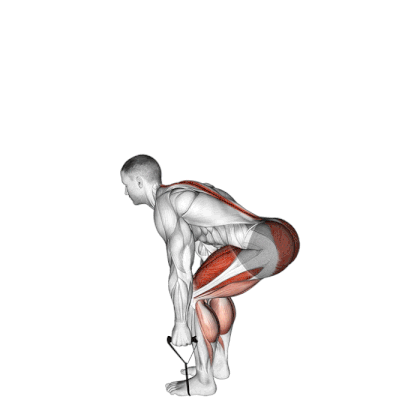
How To Do
- Place the elastic at your feet, with both ends of the band at your sides.
- The band ends should rest evenly on each side of your feet, creating balanced resistance. Ensure your feet are firmly planted and stable.
- From here, hinge at your hips and bend forward with a straight, strong spine. Keep your chest lifted as you reach down to grasp both ends of the band.
- Raise yourself to a standing position by pushing with your legs and contracting your glutes and hamstrings.
- Then bend your hips and knees to return to the starting position while keeping your back straight and controlling the movement.
7. Resistance Band Step-Ups
Resistance band step-ups are a great way to improve lower body strength and build quad muscle in the legs.
The stepping action can help improve hip, knee, and ankle mobility.
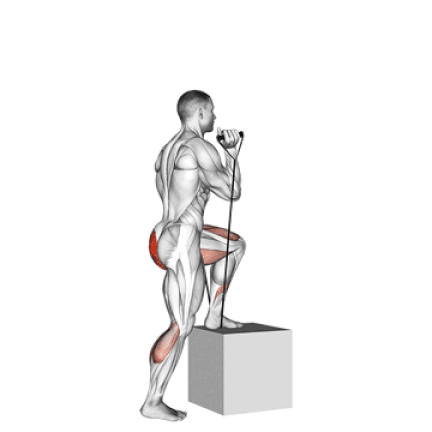
How To Do
- Stand in front of a box or stable platform. The resistance band should be looped under one foot and the other end should be close to your chest or shoulders.
- Begin with feet hip-width apart, chest lifted, and core engaged.
- Step one foot onto the platform and press through the heel, lifting your body upwards.
- Complete the motion by standing fully atop the platform.
- Control your descent as you step backwards to the ground, maintaining balance.
- Perform desired reps on one leg, then switch to the other.
Resistance Band Beginner Quad Workout Plan
For a beginner resistance band quad workout, try the following routine:
| Exercise | Sets | Reps | Rest |
|---|---|---|---|
| Band Squat | 3-4 | 10-12 | 90s |
| Band Leg Extension | 3-4 | 12-15 | 90s |
| Band Leg Press | 3 | 12-15 | 90s |
| Band Box Lunge | 3 | 10-12 | 90s |
Intermediate Resistance Band Quad Routine
Duration: Flexible
Training Level: Intermediate to Advanced
Frequency: 2 Days/Week
Equipment: Heavy Resistance Bands
Workout Plan:
| Exercise | Sets | Reps |
|---|---|---|
| Banded Front Squats | 4 | 8-10 |
| Banded Split Squats | 3 | 8-10 (each leg) |
| Banded Squat to Press | 3 | 10 |
| Banded Lateral Lunges | 3 | 10 (each side) |
Conclusion
Resistance bands are a great way to strengthen and tone all the muscles of your leg muscles. They’re a versatile and affordable way to work out your quads at home or at the gym.
With resistance bands, you can do many different arm exercises that work all the major muscle groups in different ways.
If you do resistance band workouts regularly, your lower body muscles will get stronger and have more definition.
Know More Resistance Band Exercises
- Best Resistance Band Chest Exercises
- Resistance Band Back Workouts
- Best Resistance Band Shoulder Exercises
- Resistance Band Trap Exercises
- Best Resistance Band Tricep Exercises
References
- Gooyers CE, Beach TAC, Frost DM, Callaghan JP. The influence of resistance bands on frontal plane knee mechanics during body-weight squat and vertical jump movements. Sports Biomechanics. 2012;11(3):391-401. doi:10.1080/14763141.2012.654503
- Anderson, Corey E; Sforzo, Gary A; Sigg, John A. The Effects of Combining Elastic and Free Weight Resistance on Strength and Power in Athletes. Journal of Strength and Conditioning Research 22(2):p 567-574, March 2008. | DOI: 10.1519/JSC.0b013e3181634d1e
- Nyberg A, Hedlund M, Kolberg A, Alm L, Lindström B, Wadell K. The accuracy of using elastic resistance bands to evaluate muscular strength. European Journal of Physiotherapy. 2014;16(2):104-112. doi:10.3109/21679169.2014.889746

Manish is a NASM-certified fitness and nutrition coach with over 10 years of experience in weight lifting and fat loss fitness coaching. He specializes in gym-based training and has a lot of knowledge about exercise, lifting technique, biomechanics, and more.
Through “Fit Life Regime,” he generously shares the insights he’s gained over a decade in the field. His goal is to equip others with the knowledge to start their own fitness journey.
